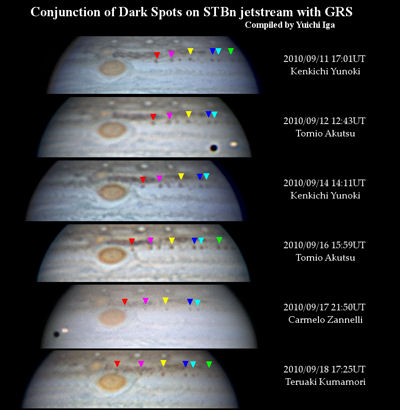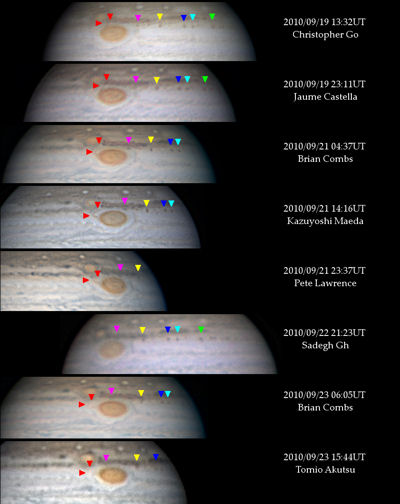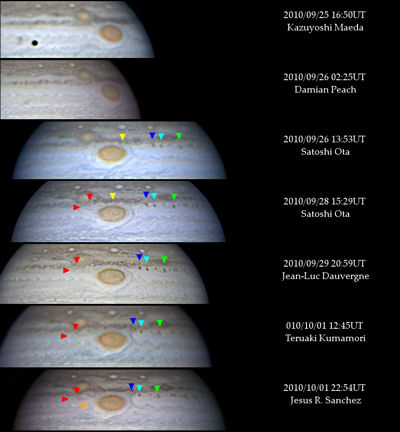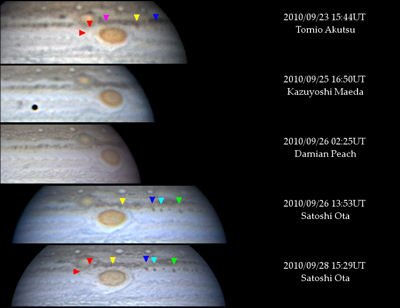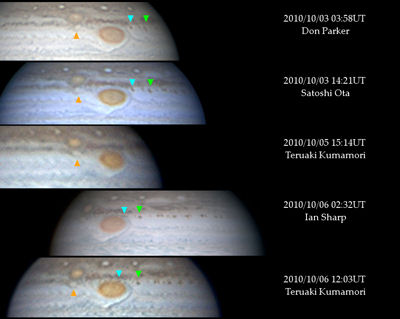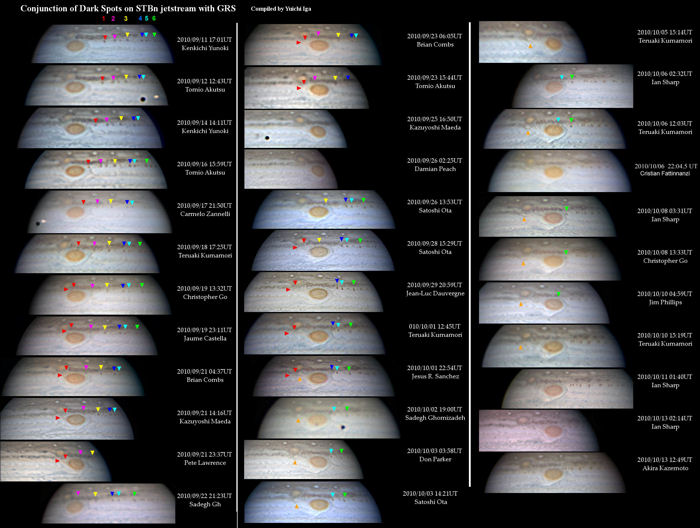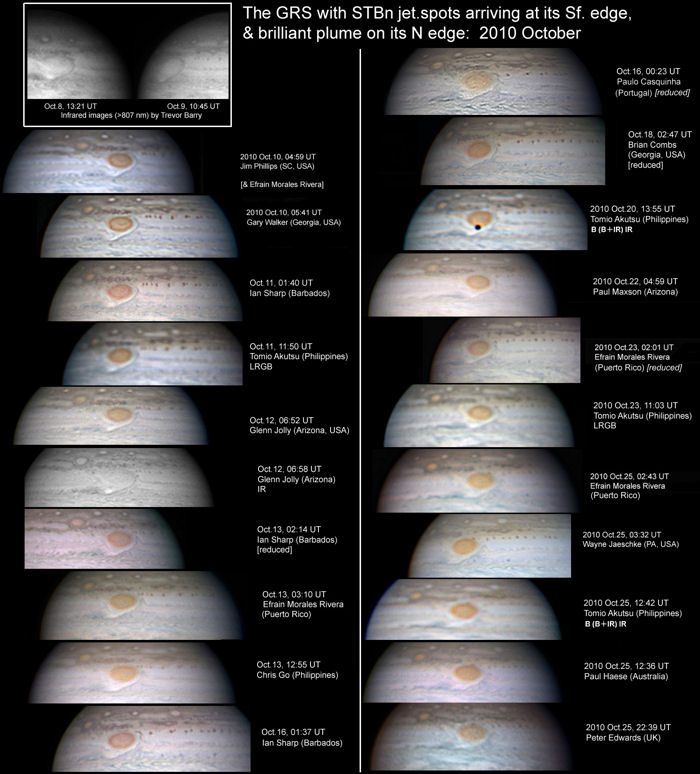|
Jupiter in 2010 - Report no.12
The Great Red Spot and spots moving around it (continued)
John Rogers, Yuichi Iga, & Toshirou Mishina : 2010 Nov.6
In 2010 September, Jupiter reached its closest opposition for 47 years, so the amateur images showed more detail than ever before. Here we report continuing observations of the various spots moving around the GRS. The GRS continues to retrograde, being at L2 = 156 around Oct.1 and 159 around Nov.1.
STBn jet-stream spots encountering GRS
(analysis mainly by Yuichi Iga)
Now that Oval BA has passed the GRS, STB-2 lies alongside it, and a train of STBn jetstream spots has been arriving at the f. end of both. Yuichi Iga has analysed what happens to them. The first two spots veered S to pass between the GRS and STB-2. The first one changed to a white spot as it passed the S side of the GRS, and then expanded into an orange cloud on the p. side of the GRS (Sep.21) - just like the Baby Red Spot did in 2008 -before reassembling into a bright spot on STBn prograding past oval BA. The second spot disappeared as it passed S of the GRS (Sep.23). The third and fourth spots changed into white spots when they reached the f. end of the GRS and STB-2 (Sep.26, Oct.1), then disappeared. The fifth spot also disappeared at the f. end of the GRS and STB-2 (Oct.6). The sixth spot, however, halted at this location and merged into the vertical dark line around the f. side of the GRS (Oct.8). In many of these cases, the last image of the jetstream spot resolved its disruption as a tiny streak.
Although all but the first spot disappeared alongside the GRS, traces of them did emerge as a growing stack of oblique bright and dark streaks Sp. the GRS - especially well shown in the v-hi-res images on Sep.28 (S. Ota) and Oct.3 (G. Walker) and Oct.8 (I. Sharp, T.Barry in IR). At least one of these has again rounded up to form another prograding bright spot on STBn alongside oval BA (Oct.1-8). So, the dark spots have all been disrupted, but traces of them survive and can reassemble into vortices after the passage.
In contrast, the conspicuous sixth spot, which merged with the narrow column just f. the GRS, seems to have spread down it to generate a dark streak spreading f. along SEBs on Oct.10-12 -- dissipating thereafter. Another STBn dark spot began the same journey on Oct.18 (Fig.2). Then on Oct.23-25, when the next spot arrived at the GRS, it was distorted but did speed through the channel S of GRS, very fast. Even more analysis could be done if anyone has time.
Bright plume N of the GRS
(analysis by T. Mishina & JHR)
The bright white plume has erupted again N of the GRS, starting on Sep.22-23. It was also seen bright in methane images on Sep.23 and Oct.3 (Tomio Akutsu, Don Parker), though it was rather small and variable up to that time. Chris Go first pointed out that the northern edge of the GRS was very bright on Oct.6.
On Oct.6, the plume was brighter in methane images (T.Akutsu & A.Yamazaki) and also in visible light. On Oct.8-13 it was very bright in visible light, esp. when near the limb, indicating its high altitude; a thin dark string was expanding west of (f.) this bright spot around the Red Spot Hollow as far as the STB; and the blue triangle east of (p.) the plume was expanding to the east. All these phenomena recapitulate previous appearances of this bright plume.
It was particularly bright on Oct.12 & 13, as Glenn Jolly and Chris Go both remarked. The plume was also methane-bright, and growing: The E-W extent in methane images was 7500 km on Oct.12 (Yunoki, Yamazaki) and 13200 km on Oct.13 (Go), i.e. growth of 5700 km in 7 days.
It was faded somewhat after Oct.13, but was back in full force by Oct.23, when it was well shown in the images by Tomio Akutsu and Don Parker, in both visible and methane bands. As they pointed out, it was a very distinct methane-bright spot on that date. By then it had become quite extended in longitude.
On Nov.6 (Sadegh Ghomizadeh & Chris Go), the white plume had disappeared (in visible and methane). But the blue-grey triangle Np. it was still very distinct.
We don’t yet have recent measurements of the plume and its environs, but in July, when the plume was present, the JUPOS chart showed several dark spots prograding at DL2 ~ -80 to -90 deg/month within the blue streak or at its p. end. This motion agrees nicely with what we found in 1990 Feb., when the p. end of the blue streak extended at DL2 = -92 deg/mth for a few days.
John H. Rogers, Ph.D.
Jupiter Section Director,
British Astronomical Association.
To PageTop
| 